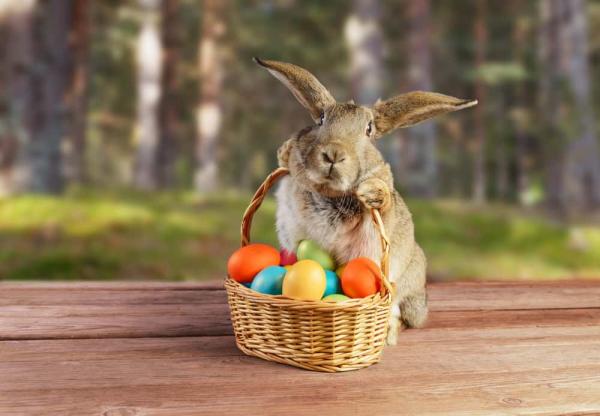
We have nothing against bunnies at Easter time. It's just that they need to be put in their proper place. If bunnies are part of your usual Easter festivities, try using them to assist in telling the story of the real reason we celebrate Easter. Parents who revere and honor Jesus Christ will teach their children that Easter is not about the bunnies and colored eggs but about how Christ lived, died and then rose from the dead - for all of us. Because of Him, we too will live.
Families get caught up in a cultural revolution of sorts, focusing more on bunnies and eggs than on Christ. According to an article in The Christian Post, "The Easter Bunny is German in origin. He shows up in 16th century literature as a deliverer of eggs, in his own way a springtime St. Nicholas bent on rewarding the good ... Colored eggs were left only for well-behaved, good children."
"As Christianity spread, the egg was adopted as a symbol of Christ's resurrection from the tomb (a hard casket from which new life will emerge)."
These symbols have become engrained in our culture, so if you have young children, here's something you can do to incorporate bunnies and eggs into your religious celebration of the season. As you fill your children's traditional Easter baskets with chocolate bunnies and decorated eggs, try something a little different. In one of the plastic eggs, put a small picture of Christ. Then, leave another egg empty with a note that says, "He is not here. He is risen."
As your children open these special eggs, tell the story of Christ's crucifixion and resurrection. Be ready to read the story of how Mary Magdalene went to the tomb and found the stone rolled away and an angel declaring, "He is not here. He is risen." Explain Mary's joy when Christ appeared to her and she realized Christ had indeed risen from the dead. Find the full story in Mark 16.
If you live near a cemetery where a loved one is buried, take your Easter baskets and go visit the grave. Have a picture of the departed loved one in each Easter basket. Sit around the grave and let each member of the family share a memory of your cherished loved one. Then, show a picture of Christ and explain what He did for your family so that you can all be with that loved one again. This activity will bring Easter to life for your family - a joyful promise that will comfort and bless you all. Share your own thoughts and feelings of gratitude for what the Savior has done for you. For a child, nothing is more powerful than hearing parents share testimony of a divine principle or belief.
We often see beautiful white lilies during the Easter season. The Toronto Sunreports, "The lily is mentioned frequently throughout the Bible and serves today as a beautiful reminder of the significance of the Easter season. Easter lilies grace homes and churches each spring as a symbol of purity, joy, hope and life." Having one of these beautiful Easter lilies in your home can be a visual reminder of your faith in Christ and the hope He brings. Be sure to explain this connection to your children so they will think of Christ when they see the lily.
Easter is a sacred holiday for all Christians. Of course, we honor, revere and follow Christ each day of the year, but at Easter, we remember not only that he died for us but also that he was resurrected and still lives, watching over us. It is a time to remember that, because of what He did for us, we will live again after this life. What a glorious message. Perhaps a picture of Christ, along with this verse, could be hung in your home as part of your celebration: "... I am the resurrection and the life: he that believeth in me, though he were dead, yet shall he live" (John 11:25, King James Version).
Take your family to church on Easter Sunday. Let them feel the joy of worshiping Christ at the sanctuary of your choice through beautiful music and inspiring messages. Let this become a family tradition. If parents do not make these things happen, Easter will become no more than a pagan holiday without rich spiritual meaning.
Happy Easter to you and your family.

